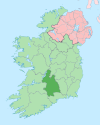New Birmingham
New Birmingham
Gleann an Ghuail | |
|---|---|
Village | |
 Church of St. Patrick & St. Oliver, Glengoole | |
| Coordinates: 52°37′05″N 7°38′16″W / 52.618°N 7.6377°W | |
| Country | Ireland |
| Province | Munster |
| County | County Tipperary |
| Elevation | 172 m (564 ft) |
| Time zone | UTC+0 (WET) |
| • Summer (DST) | UTC-1 (IST (WEST)) |
| Irish Grid Reference | S245519 |
New Birmingham (known locally as Brimigim or Glengoole, Irish: Gleann an Ghuail)[1] is a small village of approximately 20 houses, in the parish of Kilcooly,[2] and the townland of Gortnahoe and Glengoole,[3] in County Tipperary, Ireland. It is located approximately 15 kilometres from Thurles and also on the R689 regional road between Urlingford and Fethard. It is within the townland of Glengoole (from Irish Gleann an Ghuail, meaning 'glen of the coal'),[4] and is in the barony of Slievardagh.
History
[edit]New Birmingham was founded by Sir Vere Hunt (1761–1818), a wealthy and eccentric Anglo-Irish landowner, with the help of Fr Michael Meighan, the local parish priest, in the early 1800s, for the workers in his coal mine at Glengoole. New Birmingham was a landlord-inspired creation whose location was chosen due to the site of a Catholic chapel. This new village was said to be very different from those established in Ulster in the early seventeenth century.[5] In his diary, he records having laid out the street pattern in person.[6] He also obtained a charter giving him the right to hold one or two markets, and several fairs every year. Hunt evidently hoped to turn New Birmingham into a major manufacturing centre,[7] with hopes to create a branch of the grand canal in order to transport coal to Dublin,[8] but he failed in this aim, as he did in most of his business ventures, due to not having the financial necessities to build this town. Historian Gillian Darley has called New Birmingham an "industrial foundation which failed to prosper, [and] remained a straggling hamlet".[9] As a result of this failure, the village was captured by the Catholic Church through the parish priest, and the landlords were withdrawn from ownership of this city, although New Birmingham is neither a landlord or chapel village.[5][clarification needed]
Inspirations
[edit]The comedian Pat Shortt, from nearby Thurles, was inspired by New Birmingham for material on several occasions. He and Jon Kenny's characters, D'Unbelievables, were said to be from Glengoolie, taken from the regional name for New Birmingham, Glengoole.[8] Residents of New Birmingham also inspired the pair for the names of their characters in an iconic Lotto advertisement from 1998.The name for Shortt's character, Buddy Brennan (known for the catchphrase "that's right"), was taken from one of the proprietor of Brennan's (O Braonain's) pub in the town.[8][10]
See also
[edit]References
[edit]- ^ "Gleann an Ghuail / New Birmingham". logainm.ie. Placenames Database of Ireland. Retrieved 17 November 2022.
- ^ Bassett, George Henry (1889). "New Birmingham, Thurles". Book of County Tipperary. Retrieved 3 December 2021 – via libraryireland.com.
- ^ "Gortnahoe & Glengoole Parish, Co. Tipperary, Ireland". glengoole.net. Retrieved 28 November 2022.
- ^ "Gleann an Ghuail Thuaidh / Glengoole North". logainm.ie. Placenames Database of Ireland.
- ^ a b Nolan, William (2004). 'A public Benefit': Sir Vere Hunt and the town of new Birmingham, Co Tipperary, 1800–1818. Dublin. pp. 415–453. ISBN 0906602424.
{{cite book}}: CS1 maint: location missing publisher (link) - ^ Lenox-Conyngham, Melosina (1998). Diaries of Ireland. Dublin: Lilliput Press.
- ^ Lewis, Samuel (1837). "Birmingham (New)". A Topographical Dictionary of Ireland.
- ^ a b c "Creedon's Atlas of Ireland Episode 1". RTE Player. 10 November 2022. Retrieved 28 November 2022.
- ^ Darley, Gillian (1975). Villages of Vision. London: Architectural Press. p. 149. ISBN 0-85139-705-0. OCLC 1921555.
- ^ "Entertainment in the Parish". glengoole.net. Retrieved 28 November 2022.


